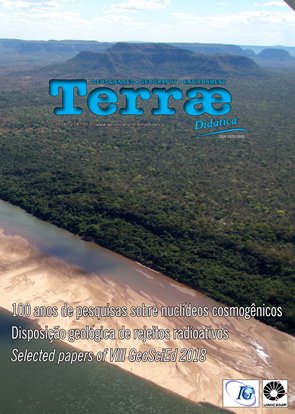Abstract
The U.S. National Research Council has called on the science education community to conduct further studies on how informal learning complements the formal classroom environment. Responding to this research need, we are developing, testing, and studying new instructional materials that integrate informal, field-based science learning into elementary teacher education. Us-ing EarthCaching as a model for teaching geosciences, the project team has developed an introductory module and seven field-based EarthCaching activities that connect to the earth and space science core ideas described in the Next Generation Science Standards. The materials are aimed at pre-service elementary teachers; however, they are appropriate for use with early child-hood and special education majors. To date we have piloted the materials over four semesters, gathering feedback through fo-cus groups to inform iterative revisions. Through the redesign process, the team has identified a set of preliminary design prin-ciples to guide other teacher educators interested in integrating EarthCaching into their instruction. These include attention to preparation, safety, and navigation; emphasis on observation, estimation, and prediction; promoting peer group interactions; presenting familiar sites from a new perspective; and highlighting cultural significance. Elementary pre-service teachers in the focus groups noted the value of taking young learners outside to EarthCache, including the opportunity to connect classroom learning to the real world and to teach geosciences locally. We anticipate that integrating informal science learning experiences into a science course for elementary pre-service teachers will increase their positive attitudes towards informal learning and in-tention to use elements of informal learning with their own students.References
Adams J.D., Gupta P. 2015. Informal science institutions and learning to teach: An examination of identity, agency, and affordances. Journal of Research in Science Teaching. DOI: 10.1002/tea.21270.
Braund M., Reiss M. 2006. Towards a more authentic science curriculum: The contribution of out‐of‐ school learning. International Journal of Science Education, 28(12):1373-1388.
Brown J.S., Collins A., Duguid P. 1989. Situated cognition and the culture of learning. Educational researcher, 18(1):32-42.
Bybee R., Taylor J.A., Gardner A., Van Scotter P., Carlson J., Westbrook A., Landes N. 2006. The BSCS 5E Instructional Model: Origins and Effectiveness. Colorado Springs, CO: BSCS.
Elkins J.T., Elkins N.M. 2007. Teaching geology in the field: Significant geoscience concept gains in entirely field-based introductory geology courses. J. Geosc. Educ., 55(2):126.
Eshach H. 2007. Bridging in-school and out-of-school learning: Formal, non-formal, and informal education. J. Sci. Educ. Technol., 16(2):171-190.
Griffin J. 2007. Students, teachers, and museums: Toward an intertwined learning circle. In J.H. Falk, L.D. Dierking, S. Foutz eds. 2007. In Principle, In Practice: Museums as Learning Institutions. Lanham, MD: Rowman Altamira. p. 31-42.
Hawley D. 1996. Changing approaches to teaching earth science fieldwork. In D.A.V. Stow, J.G. McCall eds. 1996. Geoscience Education and Training: In Schools and Universities, for Industry and Public Awareness (AGID special publication series, 19, pp. 243–253). Rotterdam: A.A. Balkama.
Hofstein A., Rosenfeld S. 1996. Bridging the gap between formal and informal science learning. Studies in Science Education, 28:87-112.
Kali Y., Orion N. 1996. Spatial abilities of high-school students in the perception of geologic structures. J. Res. Sci. Teaching, 33(4):369-391.
Keown D. 1986. Teaching science in US secondary schools: A survey. The Journal of Environmental Education, 18(1), 23-29.
Krajcik J., Codere S., Dahsah C., Bayer R., Mun K. 2014. Planning instruction to meet the intent of the Next Generation Science Standards. J. Sci. Teacher Educ., 25(2):157-175.
LIFE Center. 2005. The LIFE Center’s Lifelong and Lifewide Diagram. Stevens R., Bransford J., Stevens A. Retrieved October 24, 2015 from http://www. life-slc.org/about/about.html.
Locke S., Bracey G., Lewis G. 2014. Who EarthCaches and why: Results of an exploratory survey. Geological Society of America Abstracts with Programs, 46(6), 243.
Mason J.L. 1980. Field work in earth science classes. School Science and Mathematics, 80(4):317-322.
McKeown-Ice, R. 2000. Environmental education in the United States: A survey of preservice teacher education programs. The Journal of Environmental Education, 32(1):4-11.
Michaels S., Shouse A., Schweingruber H. 2008. Ready, set, science! Putting research to work in K-8 science classrooms. Washington, D.C: National Academies Press.
Mogk D.W., Goodwin C. 2012. Learning in the field: Synthesis of research on thinking and learning in the geosciences. In Kastens K.A., Manduca C.A. eds. 2012. Earth and Mind II: A Synthesis of Research on Thinking and Learning in the Geosciences. Geological Society of America Special Papers, v. 486, p. 131-163.
National Research Council (NRC) 2012. A Framework for K-12 Science Education: Practices, Cross-Cutting Concepts, and Core Ideas. Washington, DC: The National Academic Press.
Orion N. 1993. A model for the development and implementation of field trips as an integral part of the science curriculum. School Science and Mathematics, 93(6):325-331.
Orion N., Hofstein A. 1994. Factors that influence learning during a scientific field trip in a natural environment. J. Res. Sci. Teaching, 31(10):1097- 1119.
Plotnick R.E., Varelas M., Fan Q. 2009. An integrated earth science, astronomy, and physics course for elementary education majors. J. Geosc. Educ., 57(2):152-158.
Rebar B.M., Enochs L.G. 2010. Integrating environmental education field trip pedagogy into science teacher preparation. In: A.M. Bodzin, B. Klein, S. Weaver. eds. 2010. The inclusion of Environmental Education in Science Teacher Education. The Netherlands: Springer. p. 111-126.
Reiser B.J. 2013. What professional development strategies are needed for successful implementation of the Next Generation Science Standards. In: Paper written for the Invitational Research Symposium on Science Assessment, September (v. 24, p. 25).
Rickinson M., Dillon J., Teamey K., Morris M., Choi M.Y., Sanders D., Benefield P. 2004. A review on outdoor learning. Field Studies Council, Shrewsbury, UK.
Traphagen K., Traill S. 2014. How Cross-Sector Collaborations are Advancing STEM Learning. Los Altos, CA: Noyce Foundation.
Tretinjak C.A., Riggs E.M. 2008. Enhancement of geology content knowledge through field-based instruction for pre-service elementary teachers. J. Geosc. Educ., 56(5):422-433.
Trygstad P.J., Smith P.S., Banilower E.R., Nelson M.M. 2013. The Status of Elementary Science Education: Are We Ready for the Next Generation Science Standards? Retrieved October 2, 2014 from http:// www.horizon-research.com/horizonresearchwp/ wp-content/uploads/2013/12/The-Status-of-Elementary-Science-Education_paper.pdf
A Terrae Didatica utiliza a licença do Creative Commons (CC), preservando assim, a integridade dos artigos em ambiente de acesso aberto.

